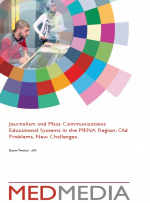Jordan Media Institute - Amman
On Thursday, forty days after the death of the artist Muhanna Durra, Jordan Media Institute hosted a discussion on the appreciation of painting, aesthetics, and art criticism. Dr. Ibrahim Al-Khateeb and the artist Dana Shahzada partook in the panel, while Yasar Durra - the late artist’s brother - led the virtual discussion attended by JMI’s Masters students in Journalism and New Media over Zoom.
Speaking with love and passion about his late brother’s talent, apparent from the age of eight as he recalls, Yasar Durra presented the artist’s most notable paintings. He expressed that his brother was the first visual artist to exhibit abstract art in Jordan, and said his brother thought of painting like music; a medium for self-expression, and an invitation to reflect.
During the event, Durra said that writing about art requires an attentiveness to the aesthetics of our surroundings, and that we cast a discerning gaze around us. We must be able to differentiate between what is beautiful and what is not in order to form an artistic background, and to access suitable concepts and terminology for evaluating and criticizing art. This in turn opens the door to the viewer to appreciate fine art.
Durra spoke of his late brother, saying that Muhanna was always searching for simplicity. He would take something apart and put it back together using simple lines. Some of his most beautiful works use simple lines, depicting courage and bravery, the message he always wanted to transmit to viewers.
Dr. Ibrahim Al-Khateeb, a specialist in visual arts, said that painting communicates the artist’s vision, and what is going through their head. It emits musical vibrations that the viewer must listen attentively to perceive. He cited one of the late artist’s most famous quotes, “I aspire to create a visual impact, not to tell stories.”
He added that Durra was first able to demonstrate his formal skills when he painted a portrait of his teacher, George Aleef, who taught him the basics of watercolor painting. This portrait painted as an expression of loyalty and gratitude to his first teacher, later became one of Durra’s most famous works.
For her part, the artist Dana Shahzada, an art instructor at the American Community School, said that the artist is influenced by the place in which they live. This is apparent in Muhanna Durra’s work, which is also remarkable for its simplicity. Shahzada recalled that Durra always encouraged her to embrace simplicity in order to better express herself.
After showing a video clip of the late artist painting one of his abstract works, Shahzada remarked that creativity is one of the most important skills needed in the twenty-first century. It allows us to solve difficult problems, and also to use our senses in order to appreciate art in its manifold expressions. According to Shahzada, writing about art in the world of journalism and media requires diligent work. This includes visiting exhibits, analyzing paintings and identifying their components, and attempting to conjure up the aesthetic environment in which the artist lived.
The late Muhanna Durra, pioneer of Jordanian abstract and modern art, in 1954 became the first Jordanian to receive formal artistic training. He was awarded many honors, including being decorated a Knight of the Order of St. Sylvester by Pope Paul XI, receiving the Order of the Star of Jordan from King Hussein bin Talal, and the first State Appreciation Award for his contributions to the cultural development of Jordan and the world.



